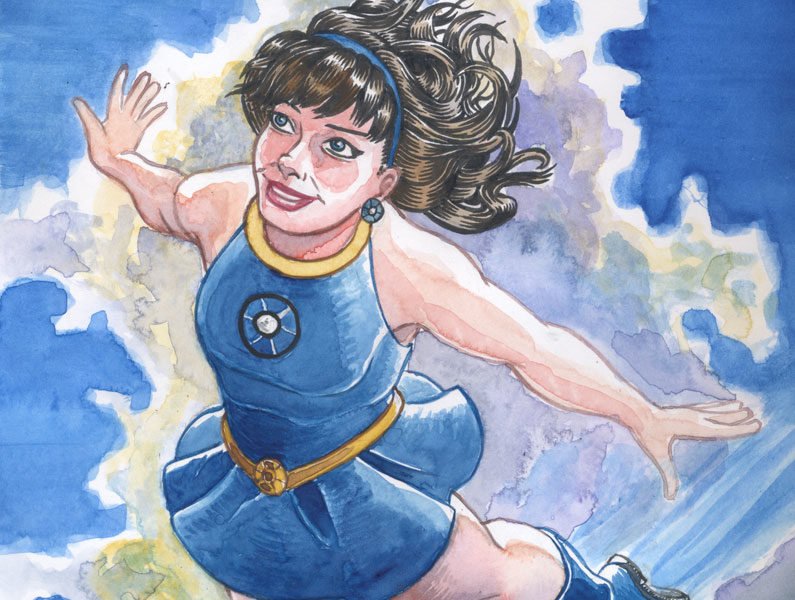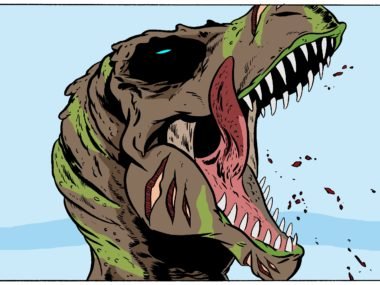Christianne creates self-published comics about trans people and zines about movies.
STL SPEX (Joceline): What are your artistic influences?
For making comics, my influences are mostly American independent cartoonists of the 70s and 80s, particularly the artists of The Studio in the 70s (Bernie Wrightson and Jeffery Catherine Jones; Jones was trans and you can sometimes feel that transness in her art) and the Hernandez Brothers. You can sometimes find a smattering of Dave Sim and Gerhardt in my comics, too, but that influence had dwindled over time. Also: Moebius, Roy Crane, Alex Toth (particularly his rule: “When in doubt, make it black.”), Colleen Doran, Alison Bechdel. My old college professor, Frank Stack, though I don’t draw or write anything like him. I don’t feel much influence by Manga or Anime except at second hand through people like Becky Cloonan or Carla Speed McNeil. I’m set in my ways.
When I was a kid, I wanted to draw superheroes and horror comics. As an adult, I find myself drawing weird little comedies and erotic transgender melodramas. You never can tell.
Since I have some movie zines this year, my main influences as a film writer are people like James Agee and Greil Marcus. Not so much film writers who approach it as a consumer guide.

STL SPEX: Who do you create for?
I mostly create for myself, but in doing so, I create for people who are like me. Particularly transgender people. I think this is important because left to their own devices, cis people who make stories about trans people usually stumble over transition narratives and tragedies (I don’t generally do tragedies). I find this tendency morbid.
STL SPEX: What does your comic-making process look like?
I don’t really understand my writing process. Most of my stories spring into my head fully formed, usually from things that have been percolating in my subconscious for a while. I don’t write formal scripts. Instead, I go straight to thumbnails, usually indicating everything with stick figures. Obviously, this is different if I’m working with a writer.

STL SPEX: What are your go-to tools for making comics?
I draw my comics on 11″ x 17″ Strathmore or Canson Bristol board. I’m thinking of scaling this size down for speed of production, though, to maybe 9″ x 12″. I used to do it on the stuff that’s already lined for comics including all the printer’s marks, but I found that those lines acted as a resist for the ink I use (I use Sumi ink) and I wound up having to correct this in the computer once I scanned the finished pages. These days, I line everything myself with a pencil. I draw with run-of-the-mill pencils and then erase them after inking. I rarely draw with blue pencils. I ink directly over the drawn pages, which is risky sometimes. I’ve had my share of catastrophic inking accidents. I ink with a #2 watercolor brush, though I sometimes use Pitt pens. I spot blacks with an old brush that’s been wrecked by ink for anything else. I generally letter digitally in Adobe Illustrator, but sometimes I letter by hand. I just eyeball that rather than using lettering guides, which are too fiddly for my tastes. I’m not respectful of panel borders when I draw word balloons. If I’m making comics in color, I’ll color them in Photoshop. I have a script to render inked pages into layers for flatting and coloring that also turns the lines into a mask if I want to color the lines, too. On a couple of occasions, I’ve painted my comics instead of drawing them in ink, usually in watercolor and gouache on a 300-lb. hot-press watercolor paper (Fabriano Artistico or Arches, depending).
Since I print most of my comics myself, I generally stick to black and white, though.






